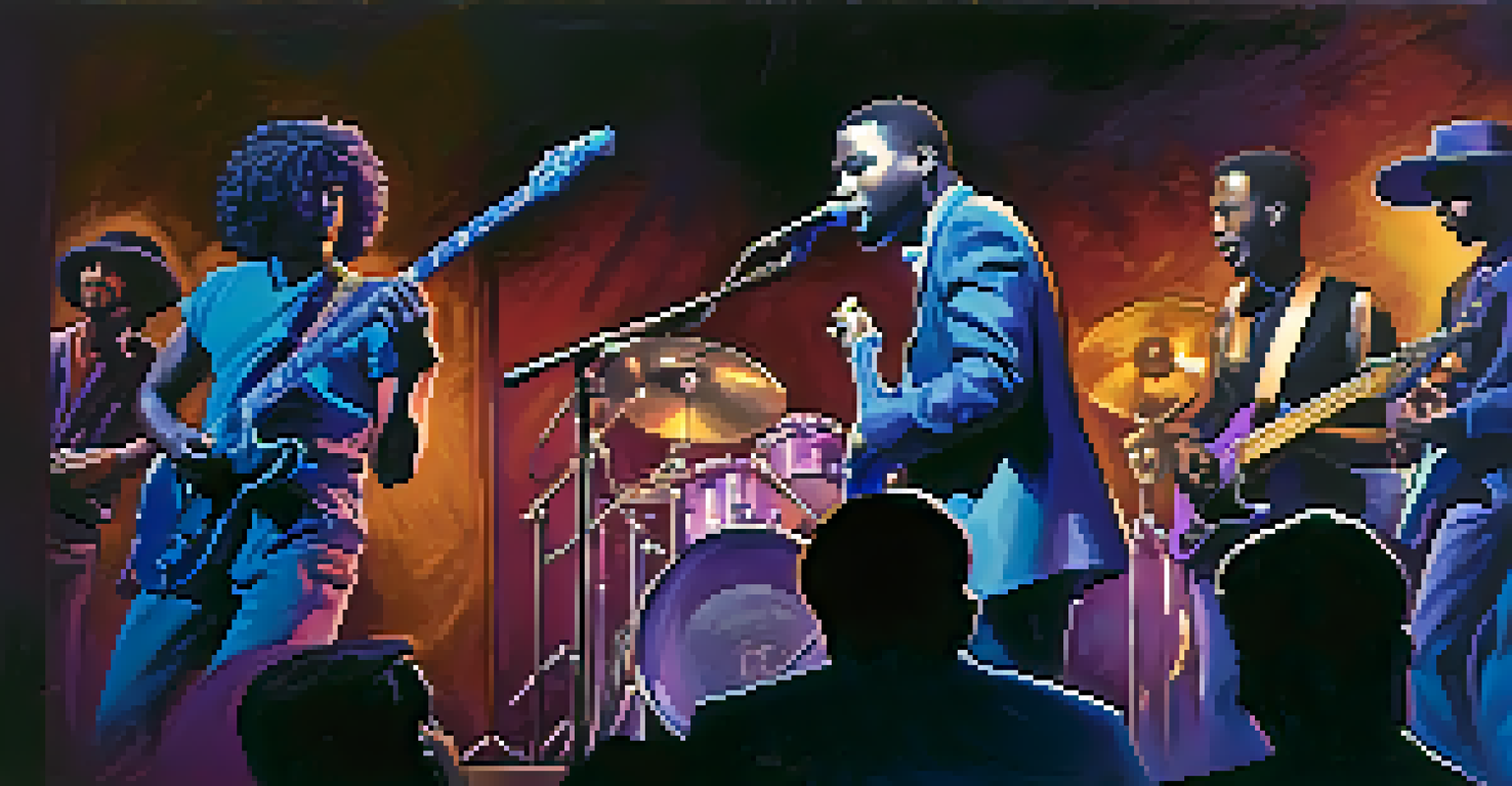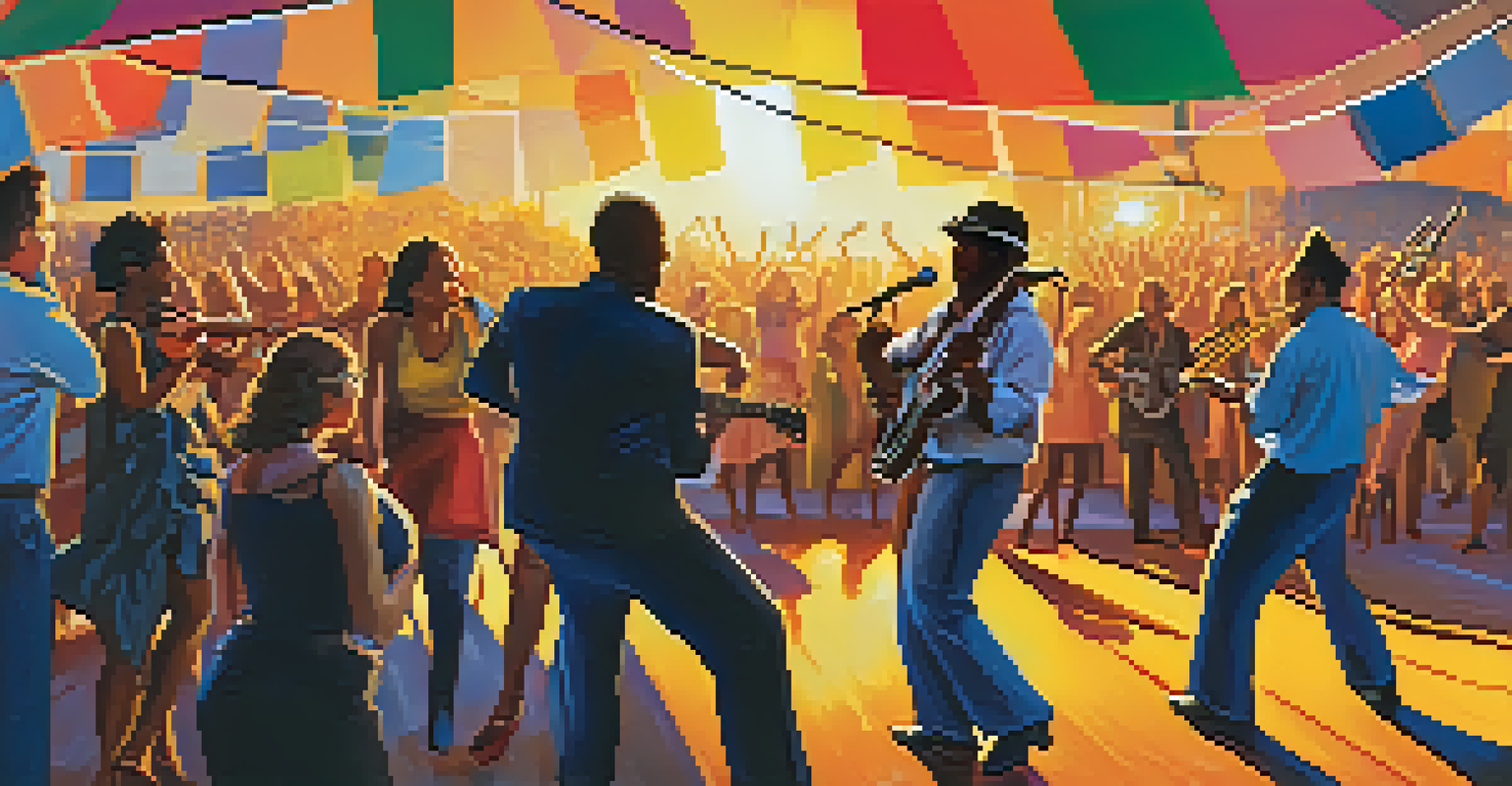The Impact of Blues on Guitar Styles and Techniques

Understanding the Roots of Blues Music
The blues, which originated in the Deep South of the United States, is a genre rooted in African American history. Its origins can be traced back to the late 19th century, where it emerged from spirituals, work songs, and folk music. This rich tapestry of influences created a sound that was both unique and deeply expressive, laying the groundwork for many modern musical styles.
The blues is a tonic for whatever ails you.
At its core, blues is often characterized by its use of the twelve-bar structure, which provides a framework for improvisation and emotional expression. This format allows musicians to convey their feelings and experiences, often relating to hardship and resilience. It's this emotional depth that has captivated audiences and influenced countless artists over the decades.
As blues musicians began to popularize their craft, the genre not only carved out its own identity but also began to seep into other music genres, paving the way for the evolution of rock, jazz, and beyond. The raw emotion and innovative techniques developed in blues have become cornerstones of contemporary music, making it essential to understand its impact on guitar styles.
The Signature Guitar Techniques of Blues
Blues guitar is known for its distinct techniques, including bending notes, slide guitar, and fingerpicking. These techniques add a unique flavor and expressiveness to the music, allowing guitarists to mimic the human voice's nuances. For instance, bending strings can evoke an emotional response, making listeners feel the pain or joy conveyed in the song.

Another popular technique in blues is the use of the slide, which involves gliding a metal or glass object along the strings to create smooth, glissando sounds. This method, often used in Delta blues, gives a haunting quality to the music, connecting deeply with the listener's emotions. Artists like Robert Johnson and Muddy Waters have mastered this technique, influencing generations of musicians.
Blues: The Foundation of Modern Music
Blues music has significantly influenced various genres, including rock, jazz, and country, shaping their sound and techniques.
Fingerpicking is also prevalent in blues, allowing players to create complex rhythms and melodies simultaneously. This technique not only showcases the guitarist's skill but also adds depth to the music. The combination of these signature techniques has established a foundation for many guitarists, helping them develop their own styles while paying homage to the blues.
The Role of Improvisation in Blues Guitar
Improvisation is a key element of blues music, allowing guitarists to express their creativity spontaneously. Unlike classical music, which often adheres to strict compositions, blues encourages musicians to explore and innovate during performances. This freedom enhances the emotional impact of the music, making every performance feel fresh and unique.
Blues is the foundation of all modern music.
Many blues guitarists draw from a shared vocabulary of licks and phrases that have been passed down through generations. This shared language allows them to connect with fellow musicians and audiences alike, fostering a sense of community. For example, a simple blues lick can evoke nostalgia, while a new twist on it can bring excitement to the performance.
Improvisation also empowers guitarists to tell their own stories through music. As they navigate the fretboard, they can weave personal experiences into their playing, creating a visceral connection with listeners. This improvisational aspect not only enhances the performance but also solidifies the blues' position as a powerful form of expression.
The Influence of Blues on Rock Guitar
Blues has had a profound influence on rock guitar, shaping the sound and style of countless rock musicians. Pioneering artists like Eric Clapton, Jimi Hendrix, and B.B. King drew heavily from blues techniques, incorporating them into their rock performances. This blending of genres has created some of the most iconic moments in music history.
The signature guitar solos found in rock music often stem from blues improvisation, showcasing the emotional expressiveness that blues is known for. For instance, the use of pentatonic scales in rock solos can be traced back to blues roots, allowing guitarists to create melodies that resonate with audiences. This connection has made blues an essential part of rock's DNA.
Key Guitar Techniques in Blues
Signature techniques like bending notes, slide guitar, and fingerpicking add emotional expressiveness and depth to blues music.
Moreover, rock bands frequently adopt the twelve-bar blues structure in their songs, proving that the influence of blues is ever-present. Whether it’s the crunch of an electric guitar or the rhythmic backbeat of the drums, the spirit of blues continues to thrive in rock music, demonstrating its lasting impact on the guitar landscape.
Jazz and Its Bluesy Undertones
Jazz, often seen as a sophisticated and complex genre, owes much of its development to the blues. The improvisational nature of jazz aligns closely with blues, allowing musicians to express their creativity freely. Many jazz guitarists, like Wes Montgomery and Grant Green, incorporated blues elements into their playing, creating a unique fusion that reshaped the genre.
Blues inflections can be heard in jazz guitar solos, where players often utilize bends, slides, and syncopated rhythms. This blending of styles creates a rich tapestry of sound, showcasing the versatility of the guitar. The ability to switch between genres demonstrates the guitar's adaptability and highlights the interconnectedness of musical styles.
Furthermore, jazz standards frequently employ blues progressions, proving that the influence of blues runs deep within the genre. This connection emphasizes the importance of blues as a foundational element in music, inspiring countless musicians to explore new creative avenues while honoring their roots.
Country Music: A Bluesy Connection
The relationship between blues and country music is often overlooked, yet it is a significant one. Both genres share common roots in American folk traditions, and many country guitarists have drawn inspiration from blues techniques. This connection is particularly evident in the use of slide guitar and storytelling lyrics that evoke emotional depth.
Many country songs incorporate the twelve-bar blues structure, showcasing the influence of blues on the genre. Artists like Johnny Cash and Willie Nelson have blended blues elements into their music, creating a sound that resonates with fans from both genres. This fusion has led to the emergence of sub-genres like country blues, further solidifying their connection.
Improvisation: Heart of Blues Guitar
Improvisation in blues allows guitarists to creatively express personal stories, enhancing the emotional impact of their performances.
The storytelling aspect of blues also finds its way into country music, with both genres exploring themes of love, loss, and resilience. This shared narrative style allows listeners to connect with the music on a deeper level, demonstrating how blues has helped shape the storytelling tradition in country music.
Modern Guitar Styles: The Legacy of Blues
Today, the influence of blues can be seen across a myriad of modern guitar styles. Genres like pop, funk, and even heavy metal have adopted blues techniques, showcasing the versatility and timelessness of the genre. Guitarists continue to draw inspiration from the emotive power of blues, incorporating its elements into their own unique sounds.
For instance, many contemporary pop artists utilize bluesy guitar riffs to create hooks that resonate with listeners. This blending of styles not only keeps the spirit of blues alive but also introduces it to new audiences. By incorporating blues elements into modern music, artists are paying homage to the genre's rich history while evolving it for future generations.

Furthermore, blues festivals and guitar competitions celebrate the genre's legacy, inspiring young musicians to explore its depths. As they learn to play, they discover the techniques and emotions that have defined blues for over a century. This ongoing interest ensures that the influence of blues will continue to shape the world of guitar for years to come.